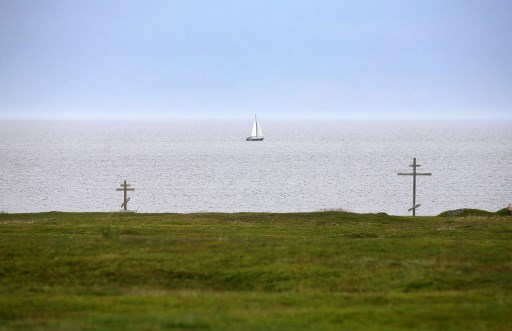Fossil fat reveals earliest known animal, 558 million years old

The fossil for the current study came from cliffs near the White Sea [pictured] in the northwest of Russia. Image: AFP PHOTO / DMITRY KOSTYUKOV
Was it a mossy plant? A giant single-celled amoeba? A failed experiment of evolution? Or the earliest animal on Earth?
After digging one of these fossils off a cliff in Russia and analyzing its contents, researchers discovered molecules of cholesterol, a type of fat.
And they found their answer. The creature, known as Dickinsonia, is the Earth’s earliest known animal.
“Scientists have been fighting for more than 75 years” over the nature of these “bizarre fossils,” said associate professor Jochen Brocks from the Australian National University Research School of Earth Sciences.
“The fossil fat now confirms Dickinsonia as the oldest known animal fossil, solving a decades-old mystery that has been the Holy Grail of paleontology.”
The findings are reported Thursday in the US journal Science.
Dickinsonia contained rib-like segments the length of its oval-shaped body, which could grow as large as 4.6 feet (1.4 meters).
The analysis showed the animals were abundant 558 million years ago, millions of years earlier than previously thought, according to Brocks.
The creature was part of the Ediacara Biota that lived on Earth during a time when bacteria reigned, 20 million years prior to emergence of modern animal life — a period known as the Cambrian explosion.
Scientists had a difficult time finding Dickinsonia fossils with organic matter still attached.
Many of the known fossils were in Australia, and had been exposed to too many elements over many millions of years.
The fossil for the current study came from cliffs near the White Sea in the northwest of Russia.
“I took a helicopter to reach this very remote part of the world — home to bears and mosquitoes — where I could find Dickinsonia fossils with organic matter still intact,” said Ilya Bobrovskiy, a doctoral researcher at ANU.
“These fossils were located in the middle of cliffs of the White Sea that are 60 to 100 meters high. I had to hang over the edge of a cliff on ropes and dig out huge blocks of sandstone, throw them down, wash the sandstone and repeat this process until I found the fossils I was after.” NVG
RELATED STORIES:
Scientists find ‘world’s oldest’ biological colors in Sahara desert